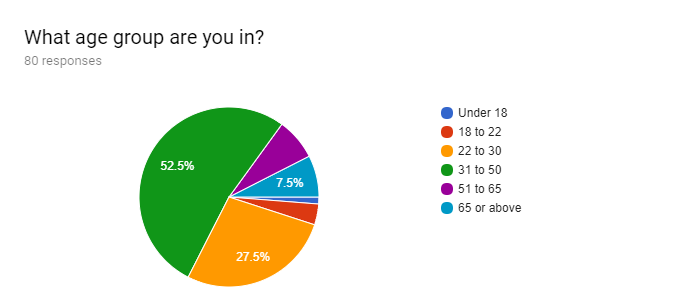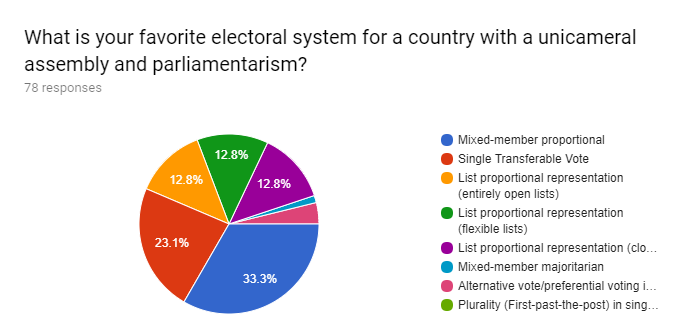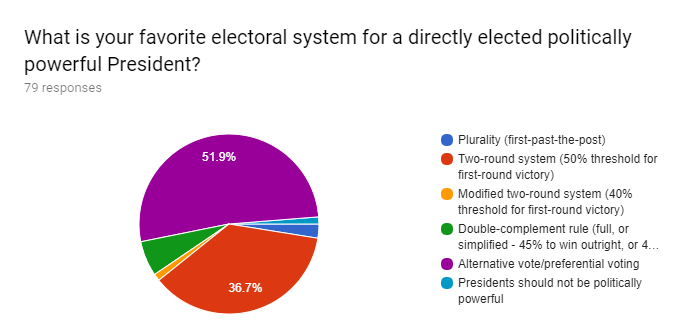I’d like to thank everyone who filled in the survey of the Fruits and Votes readership. We got a total of eighty responses, which, given the amount of views this blog receives on a regular basis, seems like enough to draw inferences from.

The United States, with roughly 4-5% of world population, represents 33% of this blog’s viewership. Australia and New Zealand, with just 0.4% of world population, represent nearly 20% of readership. It’s Asia (60% of world population, 2.5% of responses), as well as Africa (no responses whatsoever) where Fruits and Votes is disproportionally less viewed.

For reasons that should be relatively obvious to fellow readers, those under 18 are under-represented, with those over 30 being over-represented (given the Western-centric tilt of the readership, this presumably makes some sense).
85% of you come here for the votes: the remaining 15% are here for fruits and votes, while no one wants fruit only.
The most popular region, with 54% of readers enjoying posts from it (this is approval voting), is Canada, Australia and New Zealand-only 24% of readers enjoy posts from South Asia. 99% of readers enjoy reading about electoral systems (a practically Soviet figure!), while executive formats and federalism secured the approval of 55% of readers.

We asked what sort of electoral system you most liked for a country with unicameral parliaments and parliaments. A third of you went for MMP, while about a quarter opted for STV: the most popular system overall was some form of list PR, which received the support of nearly 40% of you, although division over list types split the pro-list vote. No one opted for first-past-the-post, and only four readers opted for any form of non-PR system.

Interestingly enough, by far the most popular electoral system for an elected President is probably the rarest-a majority of you opted for preferential voting, used only in Ireland and (sort of) Sri Lanka. The more popular two-round system came in a strong second, while the other options (FPTP+variations of the two-round system) made little impact. Note that the one entry for “presidents should not be politically powerful” was written in before I closed that option.

Presidential elections… Two round systems I guess are more common for that than I thought before I started paying attention. What’s the argument for them over preferential voting? They seem needlessly costly. Why run two campaigns for one term, when you could just run one and ask for a bit more info? I can’t imagine we could ever adopt something like that here in Australia, where the elite attitude seems to be that we already vote far too often for our health. (We know our next election will be early, because if it’s on time, we’ll have to have an extra election.)
LikeLike
I think at this point it’s a general reluctance to change electoral systems as well as a lack of knowledge of alternatives that leaves the two round system in place.
Also, while you may have to pay for a second round of elections, the count is quite easy because it’s two FPTP elections. Counting a national STV vote is difficult.
In the last Irish election, they had 1.7 million ballot papers spread across 43 constituency count centers. They literally sorted the papers into piles for each first preference, then phoned in the result and waited for all 43 centers to report so that they could be told who to exclude. They then took those papers and physically redistributed them to their next preference’s pile. That took 2 days, in a country very well accustomed to counting STV papers.
In the last Australian senate election, there were 12 million votes for Senate in NSW. Due to the new electoral system, each one of these ballots had to be scanned into a computer, read by an optical reader, and then verified by a human. That took over a month.
Would France be willing to wait a month to know the result of an election 36 million people voted? Would the US be willing to wait a month or more for the distribution of preferences of 137 million ballots?
I think it’s certainly the best idea in theory for any FPTP election (though I think FPTP elections should be avoided where at all possible), but the actual mechanics of counting the votes make it much more difficult.
LikeLike
The NSW AV-STV count is unusually long because it involves multiple seats, and therefore (1) surplus transfers and (2) large numbers of candidates. It is therefore not a good guide to a single-seat AV presidential race among four to eight candidates (assuming there are high nomination thresholds).
As to the first, you can’t start transferring votes until you know exactly what transfer value they have and this in turn depends on the size of the surplus. Australia has unusually generous deadlines, by world standards, for postal voting. In the recent New England by-election, Barnaby Joyce’s majority on first preferences was so large (around 65% of all enrolled voters) that the Electoral Commission could declare him legally elected on election night: even if 100% of outstanding postal votes went against him, the man with the plastic bag over his head was home and hosed. But you can’t do for all seats that with an STV count, even if the two or three highest candidates are over quota, because filling the other three or four seats using their surplus votes can’t begin until all valid ballots are received.
(I’m speaking in legal terms. Of course the political actors and/or the head of state can make an informed guesstimate on election night, although unlike Al Gore’s November 2000 premature concession, this may have legal consequences in terms of appointing a new Premier Minister and Cabinet).
As to the second issue, ticket-voting was supposed to alleviate complexity of voting and counting, but has actually exacerbated it – because you only get a ticket square and a separate column if you stand two candidates, minor parties and independents have a very big incentive to find a running-mate or two.
The Irish process could perhaps be expedited by copying the Australian practice, since circa 1983 in most jurisdictions, of keeping a double tally as the ballots are first sorted. Scrutineers note both (a) which candidate is the ballot’s first preference and (b) if the answer is “not one of the two likely leading candidates” (as estimated by the Electoral Commission and noted in a sealed envelope that’s not noted until polls close), which of those two is ranked above the other. Thus Australian scrutineers can have a good idea of the likely two-party preferred vote on election night, provided if course no third- or fourth-party insurgent places unexpectedly second. This is more likely in Irish presidential elections although it is not unknown in Australian parliamentary elections. As Antony Green noted on his excellent blog, before it was gratuitously munged by the ABC, this enables Australian electorally tragics to observe a real-life Condorcet count in relation to the South Australian electoral division of Frome.
LikeLike
What about voting on a computer kiosk with a paper ballot that printed where the voter puts it into a box, and both are cross check to compare the paper ballots to what is recorded in the computer memory? That question that I wrote is a mouthful. I hope that I am making sense. I think that such a system would work well with number ranked voting.
LikeLike
The cost of an STV scrutiny is minuscule beside the cost of a second round of elections. And we have not even begin to discuss situations like Chirac/Le Pen or Macron/Le Pen where the electorate has no choice but to vote for one candidate irrespective of that candidate’s policies.
LikeLike
Yes, what Alan said. Two of the last four French elections (2002 and 2017) have combined both the cost of a runoff with the need for tactical voting on each round.
LikeLike
Surely it’s acceptable to disagree with the premise of a question?
LikeLike
It is, sure, but this question was really just to ask people what they would say if they were forced to choose. Most people did, if you genuinely didn’t wish to answer you could skip the question, and offering a write-in that would create a separate category for each different phrasing of “presidents shouldn’t be powerful” would have created a messy result.
LikeLike
The NSW count I was referring to, the Senate count, involves typing numbers into a computer. The surplus transfer happens automatically by computer. My point was that a nationwide AV election would involve similar numbers of ballots, if not considerably more.
I believe the NSW state election count uses the same system.
LikeLike
Slight correction, but the President of India is also elected by STV. However, only members of an electoral college (basically, members of the national legislature + state legislators) get to vote. Also, each of these voters has a weighted number of votes based on whether they are state or federal legislators and and how large both the population and assembly size (for state legislators) are for their polity.
LikeLike
STV with M=1 is AV.
LikeLike
I know. I was saying that India uses the same system as Ireland for presidential elections.
LikeLike
India’s Rajya Sabha is elected by STV by the states as well. I think if there is a country with low literacy and numeracy, a number ranked system wouldn’t be the way to go, an open party list would be the way to go or 1 vote MMP with best loser for list seats.
LikeLike
They’re elected by state legislatures, where I don’t think illiteracy is a problem (could be mistaken).
I think pretty much everyone without developmental disabilities, regardless of literacy or formal education, knows how to count in sequence. They have to recognize prices. I don’t think STV would be any more of an issue than “tick the box.” Someone still has to explain to an illiterate person how to vote, and I don’t really think saying “mark them in numerical order” is that difficult.
LikeLike
Innumeracy and illiteracy are not quite the same thing. Many illiterates are able to read and write numbers. By contrast, I am only marginally numerate. 99.8% of the population can read, write, understand and manipulate numbers at a higher level than I can. I manage to survive in all-preferential world fairly successfully.
PNG has quite low literacy levels but manages to conduct successful AV elections for the national parliament, provincial assemblies and local councils, and the legislature and president of the Bourgainville autonomous government.
LikeLike
Pretty clearly the Indian presidency is not an example covered by the question, being neither directly elected nor politically powerful. The Irish presidency at least meets the first of those criteria, although certainly not the second.
Is there any presidency that meets both criteria and is elected by any sort of ranked-choice ballot? Sri Lanka (it’s not STV/AV, though). Any others?
LikeLike
The London mayor is at least the equivalent of a state governor in the US. 7 825 200 people and responsibility for policing, schools, environment and housing. I will disagree with Tom if he tries to slip the lord mayor of Brisbane in.
LikeLike
Dang, I missed the deadline (my university has unusual semester times hence an atypical crazy season). So the number of Australians, Gen-Xers and STV shills has been undercounted by 1/80th or 1.25%. Not that it changes the final positionality scores.
LikeLike